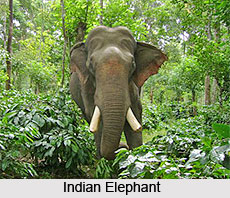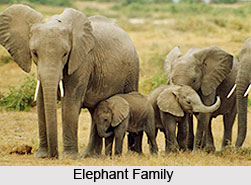 Elephant in Indian sub-continent is considered as the pride of the land`s rich diasporas. The name elephant originates from Greek word `elephas`, which means ivory. The scientific name of the Indian Elephant is `Elephas Maximus Indicus`. It is a sub-species of the Asian Elephant. It is mainly found in the Indian subcontinent though they prefer scrub forests, with plentiful supply of food supply and shaded areas. They prefer to live in muddy areas in summers where they can cool off.
Elephant in Indian sub-continent is considered as the pride of the land`s rich diasporas. The name elephant originates from Greek word `elephas`, which means ivory. The scientific name of the Indian Elephant is `Elephas Maximus Indicus`. It is a sub-species of the Asian Elephant. It is mainly found in the Indian subcontinent though they prefer scrub forests, with plentiful supply of food supply and shaded areas. They prefer to live in muddy areas in summers where they can cool off.
Features of Elephant
Indian elephant is actually the biggest animal in Asia. Elephant`s trunk is one of their unique and significant features. Elephants are mainly known for its grand built and it is considered as one of the strongest of all other animals.
The Asian elephants of the Indian subcontinent grow to a height of eight feet to ten feet. They are slightly smaller than the African elephant and weigh as much as seven thousand to eleven thousand pounds. The Asian elephants have large broad feet and thick soles below the feet. The length of the elephant varies from two hundred and sixteen inches to two hundred and fifty two inches. The Indian elephants are well known for their tusks. The tusks are usually, incisor teeth, which are made up of incisor teeth and grow up to five feet in length. Asian elephants are also found in other countries namely Bangladesh, Bhutan, China, Laos, Cambodia, Myanmar, Nepal, Malaysia, Sumatra, Thailand and Vietnam.
 Diet of Elephant
Diet of Elephant
The elephants do not stay in one place for more than a couple of days. This is because they need huge supply of food for which they have to move to new areas. The Asian Elephant is an herbivore, which survives on bamboo, berries, mangoes, bananas, shrubs, wood, apples, wild rice and coconut. Their diet also consists of twenty two to thirty gallons of water per day.
Nature of Elephant
The female elephant leads the elephant groups. Males remain isolated and rarely do they form groups. They usually join the herd during the mating season. A female elephant protects the young ones very fiercely and in her absence the other female members of the group look after the young ones. The male elephants fight to establish right over the female herd. The Indian elephants attain maturity at the age of twelve. The gestation period of the elephant is six hundred and thirty days to six hundred and sixty days. The female elephant gives birth to one elephant at a time. The baby elephant is called calf and it weighs nearly two hundred to two hundred and fifty pounds.
The Indian elephants are regarded as intelligent creatures that have strong senses of hearing and smell. They have large ears that help them to trap sounds, which other animals cannot hear. The elephants have a poor vision and with their small eyes they can see up to sixty feet distance. With their huge weight they can trample nearly all creatures and therefore they have no natural enemies. Even predators like lions, hyenas and tigers attack only young elephants and not adults. In India, a significant population of elephants is found in several national parks like Periyar National Park, Bandipur National Park and Nagarhole National Park.











